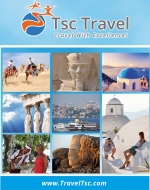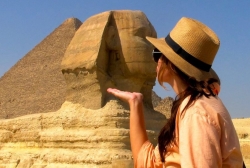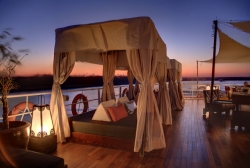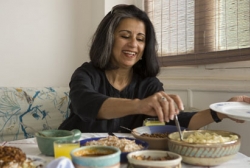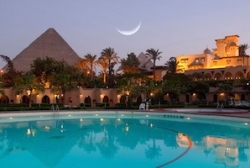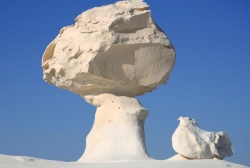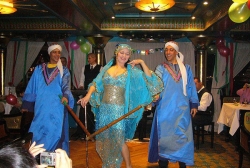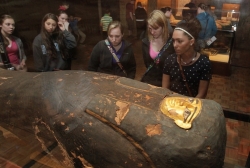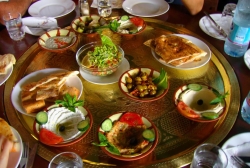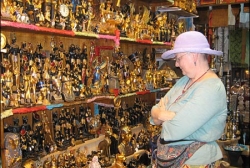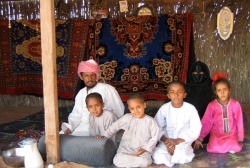ABOUT US
FIND YOUR EGYPT TRIP
Find best priced trips in Egypt..
Egypt Travel Blog
Ten Tips for Travel in Egypt
25/10/2013
Egypt, considered one of the most historical places on earth has received its fair share of praise and negative criticism over the years. Marketed as a family destination in some areas and an historical oasis in others, it firmly remains in the eyes of the world because of its heritage and current political situations. There is no denying that it is unlike other countries, so there are some helpful hints, and tips that will help you have a better travel experience.
Ten Travel Tips for Egypt
Tipping is expected so you should always carry some loose change. Even if the service is not what you expected, it is considered rude not to leave a tip. Bottled water is essential to avoid tummy upset. Never drink from the tap and in the mid-day heat, always carry a small bottle of water around with you to prevent dehydration. For souvenir shopping, learn the art of haggling. If buying in bulk, it can save you a tremendous amount of money. Research the destination you are traveling to, to ensure you pack the correct clothes. While some of the touristic resorts are not adverse to women’s beachwear, in other areas, it is wise to wear trousers and cover your arms to prevent unwanted attention The cultural face of Egypt is vastly different to other countries and if you are not an experienced traveller, you may find it daunting. For your first visit, we recommend our tours with a professional guide who will give you in-depth information from a local to enhance your trip. If you intend to travel to more than one place, research the distance carefully. While road travel is cheap, it can also be tiring because of the long distances between major attractions. Consider using the domestic airline called Egypt Air but book your tickets well in advance. Before setting out from your hotel, make sure you have the name and address, incase you get lost. This way you can easily jump into a taxi to find your way back. A local SIM card is a better option than relying on public phone boxes because in some places, they do not exist and a pre-paid card is needed to use them. Make sure you inform your bank before departing that you will be using your credit / debit card in Egypt. This will ensure any usage does not get flagged up as a security concern. If you are a solo woman traveller, avoid eye contact, dress conservatively and don’t accept food or drink from strange men as it can be perceived as a sign that you are available.Further Reading
See our wide range of tours and excursions for all destinations in EgyptCruising Down the Nile
27/09/2013
If you are looking for a unique holiday, there is no better option than a cruise of the Nile, home of the ancient Pharaohs and romantic tales of Cleopatra. Regarded as the longest river in the world, many of Egypt’s ancient and historical sites are located on its riverbanks making it an ideal way to see the major tourist attractions. In fact, the Nile can also be credited with much of the advancement of Egyptian society because of its main use as a valuable water source for crops and humans. Start by boarding a traditional Egyptian sail boat called a Felucca and sail past fishermen in their wooden boats and children playing joyfully at the water edge. Also make sure that your camera is ready for the world renowned sunsets.
Places to see on a cruise of the Nile
Luxor is often called the world’s greatest open-air museum. Previously known as the ancient city of Thebes, places to see include the large temple with its Pharaonic statues and the famous Valley of the Kings, location of the lustrous tombs of past Pharaohs South of Luxor is the ancient city of Esna. The local market is an adventure into souvenir shopping in Egypt while the temple displays marvellously intact walls carvings displaying scenes from Egyptian history and their dedication to the gods. Originally called Nubt, Kom Ombo was nicknamed the city of gold. It was a significant stopping point on trading routes but its main contribution was the impressive temples built for the gods Apollo and Isis. There is a variety of things to do in the touristic and intriguing destination of Aswan. Must see sites include the two temples of Ramses II & his Queen, Nefertiti and the temple complex that was dedicated to Horus the Falcon and the Crocodile God. The remains of ancient Edfu will thrill history lovers with its small pyramids and temple built during the reign of Cleopatra. Considered as one of the best-preserved cult temples in Egypt, it attracts hundreds of visitors every week.Further Reading
See all our tours to cruise down the Nile Read more posts from the blogEgyptian Vegetarian Cuisine
02/08/2013
Egypt, the land of the pharaohs and pyramids might seem like a haven for meat eaters but the opposite is true. Meat is available but is very expensive and therefore not consumed every day. Vegetarian dishes form most of the daily diet and have done so, throughout history because natural irrigation from the river Nile and Delta encourage easy growth of vegetable and fruit crops. Around the coastal resorts, fish is the main trend but all across the country, the staple and cheap food of bread accompanies most vegetarian meals. Used like a spoon, it will sweep the dish clean or pick up soups and stews. If you have been to other neighbouring countries like Jordan or Turkey, you will most definitely spot similarities in some dishes.
Seven Vegetarian Dishes to Try in Egypt
Ful Medames is widely available because it is one of the most common meals eaten. Consisting of pureed fava beans mixed with oil, garlic, and lemon juice, eat it on its own or as an accompaniment. Falafel is not really an Egyptian dish but more Middle Eastern. Mashed chickpeas or fava beans are formed into a ball before being deep-fried. Eaten on their own or as an appetizer, they are also served as a patty within pita bread covered with sliced vegetables and sauces. Tabouleh is a simple salad containing a variety of vegetables, sprinkled with a drizzling of olive oil and light spices. Eaten on its own or as an accompaniment, it will appear on most restaurant menus. Normally eaten as a starter, Duqqa is mixed herbs, nuts, and spices. The most commonly used nut is hazelnut. If you are eating on a budget, supermarkets also sell this Duqqa in packets. As in most Middle Eastern countries, vegetables stuffed with rice are widely common. Zucchini or Aubergines are a popular choice, but check with the waiter to ensure there is no meat in it. If you are looking for a dessert, try the fresh dates. Grown locally, they are juicy and full of taste. As well as being sold plain, they are also stuffed with hazelnuts, cashews, or almonds. Another dessert that will also be suitable for vegans is Halawa, a mix of sesame seed, sugar, vanilla and ground pistachio nuts.Further Reading
Experience all of these foods on one of our tours across Egypt, visiting historical sites and experiencing the culture. Read more about Egypt in general.Best Places to Visit in Egypt
08/07/2013
Egypt, the land of pyramids, sphinxes and about as much history as you can stomach. Existing within the continents of African and Asia, it is mostly known for its magnificent manmade structures from ancient civilizations and also the river Nile. Historians suspect civilization has existed in the region since the 10th milimenuim BC but history is not the only reason to travel there. Striking landscape views, sandy beaches, intriguing culture and traditions as well as delicious cuisine make Egypt the perfect holiday for solo, couple, group, and family travellers.
 Any trip to Egypt should start in the capital Cairo. This bustling metropolis holds many ancient buildings including one of the oldest mosques, Ibn Tulun that dates from 876AD. The Egyptian museum lures visitors with tales of pharaohs and over 12,000 artefacts including objects from the tomb of Tutankhamen. Let us not forget about the pyramid of Giza, the main reason most people visit the country. As one of the remains of the seven wonders of the ancient world, the pyramid used to hold the record of the tallest man made structure in the world. Luxor is the next popular destination because of the magnificent Valley of the Kings that is home to tombs of royalty from the 16th to 11th century BC, including the famous tomb of Tutankhamen. From there, head to nearby Karnak, the product of skilled experts and knowledge of generations of Egyptian architects and builders. It is also the largest religious site in the world.
Any trip to Egypt should start in the capital Cairo. This bustling metropolis holds many ancient buildings including one of the oldest mosques, Ibn Tulun that dates from 876AD. The Egyptian museum lures visitors with tales of pharaohs and over 12,000 artefacts including objects from the tomb of Tutankhamen. Let us not forget about the pyramid of Giza, the main reason most people visit the country. As one of the remains of the seven wonders of the ancient world, the pyramid used to hold the record of the tallest man made structure in the world. Luxor is the next popular destination because of the magnificent Valley of the Kings that is home to tombs of royalty from the 16th to 11th century BC, including the famous tomb of Tutankhamen. From there, head to nearby Karnak, the product of skilled experts and knowledge of generations of Egyptian architects and builders. It is also the largest religious site in the world.  From Luxor, depart on a cruise to retrace the history of Egypt through the long and winding river Nile. Your choice of transport can either be a luxury cruising boat or a traditional felucca. On the west bank of the Nile sits the majestic Temple of Edfu . Dedicated to the flacon god Horus and his wife Hathor of Dendera, in ancient times, it was the location of many festivals. As one of the best-preserved temples dating from 57BCE, the ancient scripts inscribed on the walls are the highlight. Natural elements and careless human acts destroyed much of the original Temple of Kom Ombo but it is still a glorious site to see. Originally built during the Ptolemaic dynasty, Roman rule ensured its majestic appearance was made even grander. The southern half of the temple was dedicated to Sobek, the crocodile god while the northern part was dedicated to Horus. Due to the large size of the high dam of Aswan, it can be seen from outer space. Originally built to control flooding of the river Nile, it is over 100 years old and stands at a magnificent 3,830 meters high. Dahab on the Gulf of Aqaba is becoming a popular destination for scuba divers, although its counterpart of Sharm el Sheikh holds the throne. This area is one of the best in the world for scuba diving thanks to the colourful reef and diversity of coral formations and sea creatures.
From Luxor, depart on a cruise to retrace the history of Egypt through the long and winding river Nile. Your choice of transport can either be a luxury cruising boat or a traditional felucca. On the west bank of the Nile sits the majestic Temple of Edfu . Dedicated to the flacon god Horus and his wife Hathor of Dendera, in ancient times, it was the location of many festivals. As one of the best-preserved temples dating from 57BCE, the ancient scripts inscribed on the walls are the highlight. Natural elements and careless human acts destroyed much of the original Temple of Kom Ombo but it is still a glorious site to see. Originally built during the Ptolemaic dynasty, Roman rule ensured its majestic appearance was made even grander. The southern half of the temple was dedicated to Sobek, the crocodile god while the northern part was dedicated to Horus. Due to the large size of the high dam of Aswan, it can be seen from outer space. Originally built to control flooding of the river Nile, it is over 100 years old and stands at a magnificent 3,830 meters high. Dahab on the Gulf of Aqaba is becoming a popular destination for scuba divers, although its counterpart of Sharm el Sheikh holds the throne. This area is one of the best in the world for scuba diving thanks to the colourful reef and diversity of coral formations and sea creatures.
Amazing Places to Visit in Egypt
 Any trip to Egypt should start in the capital Cairo. This bustling metropolis holds many ancient buildings including one of the oldest mosques, Ibn Tulun that dates from 876AD. The Egyptian museum lures visitors with tales of pharaohs and over 12,000 artefacts including objects from the tomb of Tutankhamen. Let us not forget about the pyramid of Giza, the main reason most people visit the country. As one of the remains of the seven wonders of the ancient world, the pyramid used to hold the record of the tallest man made structure in the world. Luxor is the next popular destination because of the magnificent Valley of the Kings that is home to tombs of royalty from the 16th to 11th century BC, including the famous tomb of Tutankhamen. From there, head to nearby Karnak, the product of skilled experts and knowledge of generations of Egyptian architects and builders. It is also the largest religious site in the world.
Any trip to Egypt should start in the capital Cairo. This bustling metropolis holds many ancient buildings including one of the oldest mosques, Ibn Tulun that dates from 876AD. The Egyptian museum lures visitors with tales of pharaohs and over 12,000 artefacts including objects from the tomb of Tutankhamen. Let us not forget about the pyramid of Giza, the main reason most people visit the country. As one of the remains of the seven wonders of the ancient world, the pyramid used to hold the record of the tallest man made structure in the world. Luxor is the next popular destination because of the magnificent Valley of the Kings that is home to tombs of royalty from the 16th to 11th century BC, including the famous tomb of Tutankhamen. From there, head to nearby Karnak, the product of skilled experts and knowledge of generations of Egyptian architects and builders. It is also the largest religious site in the world.  From Luxor, depart on a cruise to retrace the history of Egypt through the long and winding river Nile. Your choice of transport can either be a luxury cruising boat or a traditional felucca. On the west bank of the Nile sits the majestic Temple of Edfu . Dedicated to the flacon god Horus and his wife Hathor of Dendera, in ancient times, it was the location of many festivals. As one of the best-preserved temples dating from 57BCE, the ancient scripts inscribed on the walls are the highlight. Natural elements and careless human acts destroyed much of the original Temple of Kom Ombo but it is still a glorious site to see. Originally built during the Ptolemaic dynasty, Roman rule ensured its majestic appearance was made even grander. The southern half of the temple was dedicated to Sobek, the crocodile god while the northern part was dedicated to Horus. Due to the large size of the high dam of Aswan, it can be seen from outer space. Originally built to control flooding of the river Nile, it is over 100 years old and stands at a magnificent 3,830 meters high. Dahab on the Gulf of Aqaba is becoming a popular destination for scuba divers, although its counterpart of Sharm el Sheikh holds the throne. This area is one of the best in the world for scuba diving thanks to the colourful reef and diversity of coral formations and sea creatures.
From Luxor, depart on a cruise to retrace the history of Egypt through the long and winding river Nile. Your choice of transport can either be a luxury cruising boat or a traditional felucca. On the west bank of the Nile sits the majestic Temple of Edfu . Dedicated to the flacon god Horus and his wife Hathor of Dendera, in ancient times, it was the location of many festivals. As one of the best-preserved temples dating from 57BCE, the ancient scripts inscribed on the walls are the highlight. Natural elements and careless human acts destroyed much of the original Temple of Kom Ombo but it is still a glorious site to see. Originally built during the Ptolemaic dynasty, Roman rule ensured its majestic appearance was made even grander. The southern half of the temple was dedicated to Sobek, the crocodile god while the northern part was dedicated to Horus. Due to the large size of the high dam of Aswan, it can be seen from outer space. Originally built to control flooding of the river Nile, it is over 100 years old and stands at a magnificent 3,830 meters high. Dahab on the Gulf of Aqaba is becoming a popular destination for scuba divers, although its counterpart of Sharm el Sheikh holds the throne. This area is one of the best in the world for scuba diving thanks to the colourful reef and diversity of coral formations and sea creatures.
Suggested Tours
We have a variety of tours that travel to all or some of these places. The tours include an official guide so you can get to know Egypt further than what you see at face value. (Find out more) Alternatively, independent travellers can use our trip planner to organise their own itinerary.
THE OASES AND THE FAYYUM
25/11/2011
Ready to discover Oases? The very word “Oasis” conjures a string of images-swirling sands, blue-veiled Tuaregs, mirages, the thirsty caravan stumbling into a pool of sweet water set amidst swaying palms. As always, little of this vision has any foundation in modern reality: the caravans have all but vanished, banditry has been suppressed, and the Bedouin have traded their camels in for Toyotas. Not even the vestiges of modern man, however, in the form of asphalt, high tension wires and water pumps, are capable of concealing the truths of a harsh climate, where shifting sands can block roads for days and where the foolhardy can still meet death by thirst, exposure, or the sting of a scorpion. Nor have 20thcentury wonders obscured the essential miracle of water, gushing hot or cold from barren rock to irrigate acres of garden in the midst of a wasteland. From the Nile, the Sahara strectches 3,000 miles (5,000km) westward to the Atlantic: The world’s greatest expanse of desert is broken only by some several score dots of green, where human habitation has survived the spread of sands. Contrary to popular imagination, which sees verdure sprouting incongruously from dunes, oases generally lie in rocky lands where wind and time have scratched out vast depressions whose depths allow natural underground aquifers to reach the surface. In Egypt’s Western Desert a single aquifer flows north from Sudan, running in an arc of five oases roughly parallel to the Nile. Prehistoric remains show that man has been exploiting nature’s gift since at least 5000 BC. Under the pharaohs the four Nileward oases – Kharga, Dakhla, Farafrah and Bahariyya - formed a line of defense against marauding Libyan tribes. The camel, the only beast capable of five days’ march without water, was introcuded by invading Persians in the 6th century BC and provided the oases with their first great leap forward, matched in importance only recently with the introduction of electricity and the automobile. The camel helped to revive the desert economy. The new beast was no help to the Persian emperor Cambyses, however, when he dispatched his army from Kharga across the desert to Siwah in 525 BC. According to Herodotus, all 50,000 men were buried in a sandstorm. The Ptolemies, who ran the country like a vast estate, set about improving desert agriculture. Archeological remains show that cultivation grew to its furthest extent undertheirrule; new wells were dug with Alexandrian technology and the complex systems of water distribution that still persist were brought into use. Roman conquest led to a reversal of fortunes. The internal unrest of the late roman period saw banditry increase at the expense of sedentary agriculture, while persecutions forced Christians into desert refuge, as the many Christian remains in the oases testify. Wells that had been regularly repaired and cleaned were allowed to dry up, as a general decline in population , lasting up to the present century, set in. Although the date of the last Christian conversions to Islam is not known-the present inhabitants of the oases being solidly Muslim-it is likely that the new religion, so well suited to desert ways, made easy headway in the oases. The charm, generosity, and peaceability of the inhabitants owe much to Islam. In a landscape seemingly touched by God-abundance amidst waste-a touching humility of outlook is so appropriate as to seem unsurprising. Al-Kharga (The Outer) Oasis is the most frequented of Egypt’s oases, by virtue of its proximity to the Nile and because it is the seat of the New Valley Governorate. Although it is linked by twice-weekly flights from Cairo and Luxor, most travellers prefer the overland route. Three miles (5 km) north of Asyut, a fine paved road leads past a new industrial complex up into the desert. One hundred and twenty miles (200 km) of barren gravel later, the road descends suddenly down a magnificent cliff into the Kharga Depression, which extends southwards, narrowing at its extremity, for 60 miles (100 km). As one crosses the flat bottom of the depression, few straggly trees appear on the roadside, inauspiciously announcing the beginning of cultivation. Then Nasserite housing blocks begin to sprout, marking the entrance to Kharga town. Visitors to the oases should not be too disappointed by the town. It is merely an administrative centre and a showpiece of the New Valley project, initiated by Abdul Nasser in the later 1950s. The project, the aim of which was to utilise the vast potential of the oases’ waters for land reclamation and new settlement, has met with considerable succes. Much of Kharga’s population consists of resettled Upper Egyptians; and the new hotels, duck farms, and packaging industries point to a fair degree of prosperity. With the exception of its old market there is not much to see in the modern town, however. Just northeast of the town, not far from the main road, lies a cluster of monuments. Chief among them is the Temple of Hibis, important as one of the few remnants of Persian rule. Built of local sandstone, it was begun under Cambyses’ succesor Darius I, but not completed until the reign of Nectanebo II in the 4th century BC. The temple lies in a palm grove beyond the remains of a ceremonial pool and an avenue of sphinxes. The carving style within shows local influence, while the content of the reliefs-deities, the burial of Osiris, a winged Seth struggling with a serpent - follows a standard pattern. At the edge of culvivation to the north of the temple lies the Christian necropolis of Al-Bagawat, a huge area of mudbrick domes and vaults, some of which preserve decoration. A kilometre’s hike across the sand leads to the ruins of a fortified monastery. South of Kharga town a paved road extends through a string of smaller oases, past some minor antiqities, to Baris, the village designed by renowned architect Hassan Fathi.
Read More
Diving in the Red Sea
18/08/2011
The climatic and geographic position of Egypt’s eastern coasts is ideal for the formation of coral which can not grow at temperatures of less than 18,5 centigrade or at depths of more than 70 feet. Though the Gulf of Aqaba and the Red Sea attain a depth of 6000 feet in the middle, where the tectonic plates of Africa and Asia have drawn apart to form a great rift, relatively shallow seas cover the continental shelf that runs along the shores which are interrupted only by occasional wadis, formed by infrequent but torrential rains. The sunshine that penetrates the very salty water for many hours each day enables the coral to build up formations. There are basically four types of reefs. Fringing reefs and barrier reefs run parallel to the coast, usually with shallow sandy-bottomed lagoon between the land and the coral, which then drops steeply as much as 70 feet in a cliff like formation. There are no atolls in the Egyptian part of the Red Sea, but the fourth type of reef, roughly distinguished as a patch formation, occurs quite frequently. Mounds of coral build up on the sandy floor of the sea like islands, the tips of which are barely skimmed by the waves. Patch formations occur at Nuweiba on the Sinai coast, off Hurghada and at other spots further south. Each coral accretion consists of numerous minute anemone like individual polyps, growing together in a colony. When one colony dies, a new colony grows on top, attached to the skeletons of their defunct ancestors, so to speak. Two thousand species have been identified and christened with complex names. Even the amateur can find as many as 100 types. Delicate pinks, purples, yellows and beiges are dappled by the flitting shadows of waves. Some corals are soft and undulating, like the sea anemones; some are hard and solid, squat and rounded like brains or mushrooms; some branch like elkhorns, or stack up like fortifications, spires and pinnacles; others are fanshaped and perforated like Elizabethan lace collars. The almost miraculous forms are the same time familiar and strange. The coral reefs of the Red Sea are rivalled only by the Great Barrier Reef in Australia. Several of the modern hotels on the Sinai and Red Sea coast have affiliated diving centers with resident diving instructors, boats and equipment for hire. Diving and fishing trips are organised daily as part of these hotels’ sports programmes; the trained professional supervisors can initiate the novice into what to look for, where to see it and how to manage his gear. Reasonably efficient snorkeling equipment- mast,snorkel and flippers- can be rented by the day, but not purchased in Egypt. For those who want to take the sport seriously, it is advisable to buy and test out gear before coming. An acronym for “self contained underwater breathing apparatus” scuba proctecting the wearer from the coral. No one should attempt to scuba dive who has not completed a course of proper training consisting of at least 15-20 hours of theoratical study, followed by 20-30 hours of practical diving experience. There are dangers of running out of oxygen, gong too deep, and coming up too suddenly, all of which can be fatal. Certificates of competency are granted after a sufficient course of training. For those who are able to invest enough time, the Res Sea is an ideal practice ground for gaining mastery of scuba diving. For the less adventurous there are trips in glass-bottomed boats, sailing, wind-surfing and fishing, not to mention beachcombing, sunbathing and just doing nothing. The Red Sea beach is a wonderful playground and can be enjoyed all year round, though the optimum months are October, November, February and March.
Read More
NILE DINNER
08/06/2011
If you are in Cairo and have a free evening to enjoy, book a Nile dinner. You will explore a different Cairo from Nile side while passing by fellucas and enjoying your dinner from unique Egyptian Cuisine. A traditional Egyptian night with belly dancer and Tanoura dancers will embellish the night. Traditional Arabic music accompanied by tambourine voice will carry you to Ancient Egypt.
Read More
Mummies' World
05/01/2011
A mummy is the body of a person (or an animal) that has been preserved after death. Normally when we die, bacteria and other germs eat away at the soft tissues (such as skin and muscles) leaving only the bones behind. Since bacteria need water in order to grow, mummification usually happens if the body dries out quickly after death. The body may then be so well preserved that we can even tell how the dead person may have looked in life. Mummies are made naturally or by embalming, which is any process that people use to help preserve a dead body. Mummies can be dried out by extreme cold, by the sun, by smoke, or using chemicals such as natron. Some bodies become mummies because there were favorable natural conditions when they died. Others were preserved and buried with great care. The ancient Egyptians believed that mummifying a person's body after death was essential to ensure a safe passage to the afterlife. Mummification in ancient Egypt was a very long and expensive process. From start to finish, it took about seventy days to embalm a body. Since the Egyptians believed that mummification was essential for passage to the afterlife, people were mummified and buried as well as they could possibly afford. High-ranking officials, priests and other nobles who had served the pharaoh and his queen had fairly elaborate burials. The pharaohs, who were believed to become gods when they died, had the most magnificent burials of all. In the case of a royal or noble burial, the embalmers set up workshops near the tomb of the mummy. The art of Egyptian mummification consisted of many steps. First, the body was washed and ritually purified. The next step was to remove the deceased person's inner organs. A slit was cut into the left side of the body so that the embalmers could remove the intestines, the liver, the stomach and the lungs. Each of these organs was embalmed using natron, which served to dry out the organs and discourage bacteria from decaying the tissues. The organs were then individually wrapped using long strips of linen and placed in canopic jars. The lids of these jars were fashioned after the four sons of Horus, who were each entrusted with protecting a particular organ. Many of the pharaohs can be visited in the Cairo Museum, but the mummies of many others have not been identified. Around three thousand years ago, Egypt suffered from invasions and civil war. During that time, the Valley of the Kings was devastated by robbers, and by bureaucrats, anxious to recycle the golden treasures of the past to pay the expenses of the current kings. At this time, royal mummies were shifted from place to place and from coffin to coffin, often ending up, denuded of their jewels and fine wrappings, damaged, in the reused coffins of commoners. Could the mysterious mummy of Niagara Falls have suffered such a fate? Several things suggested that the mummy was regal. First, his hands were crossed over his chest; now empty, they had once held objects. Could those objects have been the crook and flail of kingship? Second, the mummy had always been associated with a good quality coffin of the late XVIII or early XIX dynasty; such coffins had been used by the Ancient Egyptian scribe Butehamun and his colleagues. When they had separated the royal dead from their treasures, they stored the bodies in recycled mummy cases, in the safety of secret tombs. Two of these hiding places of the Kings were found in the last century ¬ but not all of the kings were accounted for. And finally, that noble face! The Niagara Falls gentleman resembles not so much the famous Nefertiti, as the Ramesside kings of the XX Dynasty. Could this mummy have been one of them? The bodies Of Ramesses VIII, X, and XI are among the missing. Before any identification can be made, however, scientific evidence must be considered. How old are the mummies of Niagara Falls ? Do they date back to the times of the Pharaohs, or were they people who died during the Roman occupation of Egypt, or even later? Unscrupulous dealers have been known to place the bodies of folks who died only a few hundred years ago into ancient coffins. Expert radiologists came to Canada to examine the evidence. Dr. Wolfgang Pahl and his assistant Lisa Bark from Tubingen joined Dr. Eggebrecht. State-of-the-art technology was called in too, and the prototype of a mobile x-ray machine by Siemens was flown in. Jacob Sherman, the director of the Museum, gave every co-operation. Galleries were closed so that the mummies could be studied, some still in their coffins, too fragile to be moved. The handsome gentleman who was not Nefertiti was now called Niagara Falls Mummy Number Five ¬ NFM 5 . The ancient body was subjected to many tests. The interior of the body was examined by endoscope, and showed that the man had indeed been mummified. Lateral x-rays of the skull show material remaining in the occiput from the mummification process. Pahl and Eggebrecht agreed that this would be consistent with a date in the XIX or XX Dynasty. The body was measured ¬ 1.54 cm, (five foot five and a half, ) about the same height as King Tutankhamun. This is a little taller than the average ancient Egyptian, but it is the usual pattern for well-fed members of the ruling class. Back in Germany, Dr. Eggebrecht, in consultation with Dr. Pahl and his team, continued the study of the x-rays and tissue samples, not only of NFM 5, but of the other Niagara Falls mummies as well. Many factors were considered in assigning the bodies to approximate time periods. The mummy of one woman, who lived about two thousand, six hundred years ago, may well be the original inhabitant of the most beautiful of the Niagara Falls coffins; she still wears her hair in the braided style of the XXVI Dynasty. Most of the mummies, however, appear to be people who lived in Roman times. The physiological information and dates used on this website are those suggested by Dr. Eggebrecht and Dr. Pahl in their report. This report is available, in German, upon request. [The reports on NFM 4 and 5 are available in English.] Since the investigations of the mid 1980s, new techniques, such as DNA analysis have become available for the study of the ancient dead. No longer is the burning question whether a mummy can be identified as a particular historical character. We want to know about the way people lived in the past. Were they healthy? What parasites did they suffer from? What chemicals were in their environment? Did they suffer from industrial pollution? But the Mysterious Mummy is still unidentified. Who was Niagara Falls M 5? C-14 studies were later conducted by Patrick Horne . The Regal Gentleman seems to have lived about three thousand years ago. This mummy could indeed belong to the XX Dynasty ¬ at least the time period, if not the royal family. DNA analysis will be required to know if there is indeed any link between this man of Ancient Times, and the Warrior Kings of the late New Kingdom. National Geographic Television chose the Niagara Falls Museum's collection of Egyptian mummies to be included in a special documentary about the practices of ancient Egyptian mummification, titled "Mr. Mummy."
Read More
EGYPTIAN CUISINE
28/12/2010
Some of the world’s delicious and healthiest cuisine can be found in Egypt. With influences from the Mediterranean and Europe, Africa and the Middle East, the dishes of modern day Egypt combine fresh often brightly coloured vegetables and fruit straight off the trees with fish, seafood, meats and an abundance of pulses, aromatic herbs and strong spices. While many cooking praactises are much the same as they were in Pharaonic times, the period of history that saw, among others, the Ottomans and the French live alongside the Egyptians, bringing with them their very distinct style of cooking, has left an indelible mark. Typically, a meal will start with soup such as melokiyah made from green leafy vegetables. There are many soup recipes that use tomatoes, watercress, pulses or beans, with herbs such as fennel giving them a real kick. Garlic is used lavishly as onion. Spices as well. Egyptian restaurants will have rows of dishes full of brightly coloured spices that are a key ingredient. Soups are served with flatbreads like pitta. Fresh fish (samak), seafood or fish stew accompanied by rice may follow. Meat is prepared to perfection. Chicken, lamb and veal are the most popular and usually slow roasted, grilled with lots of herbs or minced and added to dishes like stuffed vine leaves. Pigeon, hamaam dish is considered a delicacy and you will find it’s always delicious. Koshari is a national dish and can be found delicately prepared on gourmet menus, as well as in fast food outlets or on street carts. Made from pasta, rice, lentiland chickpeas. All served with a thick garlic and tomato souce, topped with fried onions and herbs, it may sound a rare combination but is truly delicious. Other traditional dishes include Foul Medames, a dish of beans served with boiled eggs, and the popular falafel, a dish of spicy beans mashed together with herbs into patties and fried. Almost all meals will be served with a fresh salad, and probably some dips like humus or tahini, or the local babaganoush, a dip made from pureed eggplant. Foul is a flavour some dip made from pureed eggplant. Foul is a flavour-some dip made from beans, mashed with olive oil, lemon and herbs. Egyptian desserts usually take the form of a rice pudding made with rosewater and sprinkled with spice or yoghurt or pastries filled with figs, nuts or dates. Honey is often drenched over desserts in much the same way as is done in Middle Eastern or Mediterranean countries. Fresh fruit, especially figs and dates, as well as oranges will almost certainly be served at the end of a meal. Of course we have some suggestions for you which you can taste during your travel. Appetizers: Fatush – a loaf of local crisp bread is cut into small pieces, sprinkled with cold water and place in a salad bowl. Then chopped tomatoes, cucumber, onion, garlic cloves, lettuce and fresh mint leaves are placed over the bread. Lemon juice, sumac, salt and oil are poured over all and tossed. Fried Eggs with White Cheese – hard white cheese is sliced and fried in a skillet on both sides. Remove cheese and keep warm. Break eggs in skillet and fry. Serve the eggs along with the cheese. Season to taste. Hamam Mahsh bi Burghul – Cornish hens are skinned and sprinkled with salt and pepper. Chopped onion, fresh lemon juice, vegetable oil, cardamom, cinnamon and allspice are processed until smooth. Combine hens and onion mixture in a plastic bag and marinade in fridge for 1 hour turning bag occasionally. Remove hens and discard marinade. Bake hens for 35 minutes. Meanwhile prepare bulgur, soak currants in water for 15 minutes. Drain and set aside. Bring broth to boil, add bulgur, cinnamon, salt and pepper and simmer until liquid is absorbed. Stir in currants, pine nuts and butter. Serve with hens. Hardboiled eggs a la Alexandria – peel and slice tomatoes. Fry an onion and then add tomatoes. Shell hardboiled eggs, leaving them whole, slide onto the tomato mixture. Cook 5 min. Remove the eggs, halve, arrange on a serving dish and cover with tomato mixture. Igga baladi Omelet – 4 – 6 eggs are beaten and sifted flour, cinnamon and seasoning is added. Fry onion and stir in beaten eggs and fry. Lift edges as egg sets. Turn over and fry until both sides are golden. Omelets are usually served in thick slices. Tahina (a thick paste made from ground sesame seeds) Sauce – to tahina add water, lemon juice, salt, cumin and vinegar. Blend thoroughly. Soups: Soup is called shorbat in Middle Eastern countries. To make soup authentically Egyptian don’t skimp on the spices. Chicken Soup with Eggs and Lemon – set aside some cold soup and boil the rest of the chicken stock. Beat egg whites until frothy and then add lemon juice and cold soup. Stir until blended. When the soup is nearly boiling, add the egg mixture and cook on low, stirring to thicken, do not allow soup to boil. Hot and Sour Soup – chicken stock, lemon grass and lime rind are brought to a boil. Then the stock is strained and returned to the pan. Seasoned with salt, lime juice, chili paste and sugar. Stir well. Then straw mushrooms, bean sprouts and spring onions are added and simmered. Afterwards prawns are added and heated through. Serve in individual bowls, sprinkle with chili slices and coriander leaves. Meat Soup or Fatta – a broth is made by simmering pieces of beef or lamb in water with salt and pepper, and whole onion until the meat is tender. Discard onion. Remove meat with slotted spoon and set aside. In frying pan fry meat until browned and remove to a serving bowl. Fry garlic and stir the contents of the frying pan and vinegar into the broth and bring to a boil. Just before serving Arabic pita bread in broken up into the soup. Meat and rice are served separately. Allowing each person to serve themselves. Shorbet Ads (Lentil Soup) – onions, carrots, and tomatoes are chopped into pieces. Stock is placed into a large pot and brought to a boil. Then onions, carrots, tomatoes and red lentils are added and cooked until lentils are tender. Afterwards the mixture is pureed and returned to the pot. Onions are sautéed in olive oil and then cumin, lemon juice, the sautéed onions, salt and pepper are added to the soup. Salads: In Egypt salad is called salatat. The salads are similar to the Raita, a common side in India. Salads are light and yogurt is almost always used. They are perfect when trying to dull the palate from a spicy meal. Cucumber Chickpea Salad – mix olive oil and red wine vinegar and set aside. Combine chickpeas, chopped tomatoes, mined onions, sliced celery, chopped cucumber, minced garlic, dill and salt and pepper. Toss with the dressing and chill before serving. Lemon and Garlic Potato Salad – boiled red potatoes are combined with chopped parsley, minced garlic cloves, lemon juice, vegetable oil and salt and pepper. Salatit Krumb – sour cream, mayonnaise, lemon juice, sugar, water, salt and pepper are whisked together until the sugar is dissolved. Then cabbage, carrots, scallions and parsley are added and tossed well. Meat dishes: Chicken and Pasta Corniche – a chicken is cut into pieces and browned and set aside. Onions and garlic are sautéed. Then water, tomatoes, dry red wine, vinegar, cloves, bay leaves, paprika and cinnamon are added and brought to a boil. Afterwards the chicken is added and cooked until the chicken is tender. Remove the chicken and the bay leaves and cloves. Skim fat from sauce and set aside. Cook pasta then drain and stir into the sauce and heat through. Adjust seasonings. Serve pasta with grated parmesan and the chicken. Egyptian Kofta – beef and onions are minced twice. Bread is soaked in milk and added to the meat along with salt and pepper. Mixed well and shaped into rounds. Then grilled or fried on skewers until cooked. Lamb with Rice – lamb is cut into cubes and simmered with onions, coriander, salt and pepper and a little water until tender. Then water and milk are added to the stock and brought to a boil. Rice is stirred in and cooked until the rice is tender. The meat is arranged on top of the rice and melted butter is poured over all. Kebab Halla – beef is cut into cubes. Flour, cinnamon and seasoning are mixed together and the meat is rolled in this. Then the meat is cooked with onion and salt over a slow flame. When juice is reabsorbed, add garlic and cooking oil and fry lightly. The water is added to just cover and cooked over low heat for one hour adding more hot water as needed. The meat is served with the juice. Fish: Baked Fish – flounder, sole or red snapper fillets are arranged in a baking dish. Sprinkled with parsley, lemon juice and seasoned salt. Onion and garlic are fried. The fish is topped with the onion and garlic then tomatoes are arranged on top and lemon slices are put between the tomato slices. White wine is poured over all and baked until fish flakes easily. Fish Casserole with Hulled Grain – Fish is coated with flour then fried and removed to cool. Skin, bone and flake into large chunks. The skin, bones and trimmings are boiled with cardamom and strained. Afterwards hulled grain is fried lightly and then covered with the fish stock and cumin and garlic are added. Cooked for 10 min removed from heat and placed into a casserole dish. Fish flakes are then buried in the grain and baked. Lemon Seafood Pasta – pasta is boiled in salted water with lemon juice. Shrimp are sautéed with mushrooms and peppers. When pink and opaque the shrimp is removed. Mushrooms and peppers are cooked until soft. Then lemon juice, diced tomato, Greek dressing, butter and scrod fish cut into large pieces are added to the mushrooms. Saute and add water so the fish steams. Ready when fish flakes easily. Precooked broccoli flowerets and the shrimp are placed back into the skillet. ¼ cup liquid is removed and flour is stirred into the hot liquid until smooth then stirred back into the mixture in the skillet. The sauce will be slightly thickened. Serve over hot pasta.
Read More
Explore, Entertain and Embrace Cairo
26/11/2010
And, the story always begin in Cairo, which is one of the most fascinating places in the world. Our EgyptTourSpecialists made a list of attractions which might make your vacation much more special; Shopping in Khan el-Khalili Cairo is, by its very essence, the ultimate shopping city. Throughout its history, it played the role of waypoint in the trade between Africa, the Middle East, Europe and even the Far East. Fabrics and spices from Far East would be exchanged for silk from Italy, incense and gold from Arabic countries and Africa, woodwork from Syria and carpets from Central Asia. All these can be still found in Khan el-Khalili Bazaar and you can enjoy bargain in hundreds of shops. Enjoy magical sunset of Cairo in highest point of the city. The Cairo Tower is one of the few spots in Cairo you can get up high and have a great view. It’s also a lot cooler at the top because of the wind and its island location, making it a great escape from summer weather. Taste Egyptian Cuisine & Cook with Dina Sarhan’s Cooking Classes Dina Sarhan is opening her doors to travelers and offers courses for hobbyist cook, children, and even professional grade classes for those interested in a career in cookery. Smell the Egyptian harmony in a perfume factory People who visit Egypt talk about the Pyramids, the Sound and Light Show, the Nile River or the Red Sea. But they are not letting in on a secret; Egypt’s sensuous history still shows through its perfume. There are hundreds of perfume shops in Cairo, as Egypt is a major source of perfume oils for the Parisian market. The industry is as old as the pyramids. Experience and Learn Belly Dance by professionals A 25 years male dancer at the Mahmoud Reda Troup, he has been all around the World representing the Folkloric Dances of his native country, Egypt. Nowadays he is the teacher of the new generation dancers of the Mahmoud Reda Troup in Cairo. You can enjoy private classes and excel yourself. For more information you can contact Mahmoud Reda Troup. Dine in a cruise on fascinating Nile. It is a fabulous way to enjoy a night on the Nile while you are in Cairo. You can dine on a cruise boat sailing trip on the Nile with belly dancer, folklore show, western music and dinner on a 5 star cruise. You'll be delighted in local Chef's menu along with a selection of Egyptian favorites, made with the freshest ingredients, and prepared to make it a memorable dining experience. Enjoy Golf at the Mena House Oberoi There must be very few golf courses that can beat this location at Mena House Oberoi. One of the oldest in Cairo, this lovely course enjoys a tranquil setting beneath the shadow of the Giza Pyramids. The 18-hole golf course is open to members and hotel guests. Join diving trips of the British Sub-Aqua Club. This club welcomes people from all over the world to join its dive trips, and enroll on its free training courses. It is worth joining if you are interested in sub-aqua diving, as the British Sub-Aqua Club certificate is recognized worldwide. Members meet every other Tuesday at the British Embassy for discussions and dive-related entertainment.
Read More
Bedouins in Egypt
04/11/2010
The Bedouin are simply the best people in the desert. The Bedouin attitude to the desert isn’t sentimental. It's more like that of a coastal dwelling sailor or fisherman to the sea. He may even profess ‘to hate the desert’ but this is just a talk. The desert is in their bones and they are brought up to enjoy its bounty, its freedom and to respect greatly its dangers. Bedouin don’t take unnecessary risks. On any journey more than a walk from the highway they will take two vehicles, pick-ups usually. Sometimes you get people smugglers using a single vehicle as they cross from Sudan. These aren’t Bedouin, who would never take such a risk. In camp they are intriguing to watch. They all work in a kind of coordinated system yet without anyone giving orders. Even the head guide will do food preparation and setting up the camp. There isn’t any sense of the big leder reclining while the minions do the hard work. This sense of innate democracy extends even to travelling. Bedouin can dig their heels in and be reluctant to go somewhere. It may be because they are worried about their camels, or it could simply be that they are getting hungry themselves. But the interesting thing is they are always open to a reasoned debate. If you are set on something and can calmly but persuasively put your point across they will change their minds. Anger and ordering eventually backfire the best method is to sit down and expect a good long session of talking. Through the left hand is traditionally the one used to wipe the backside you will see they eat with both hands, though favoring the right. There is no need to be paranoid about touching someone or something with your left hand. They are far more sensitive to you putting your feet near their faces or food.
Read More

